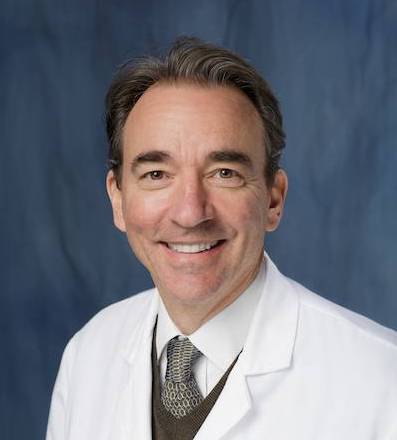
Professor Kenneth Cusi
Endocrinologists have to step up to the challenge of managing liver disease as a comorbidity in their patients with type 2 diabetes.
Speaking at the ADA 2020 virtual Scientific Sessions, Professor Kenneth Cusi said non-alcoholic fatty liver disease (NAFLD) is more common in endocrinology clinics than people realise.
While the prevalence of NAFLD as indicated by elevated liver enzymes is only about 20%, the prevalence is more like 70% using gold standard MRI imaging.
“This means almost three out of every four patients with type 2 diabetes have a fatty liver. This should be your signal to begin looking for additional possibilities for fibrosis in your patients,” he said.
“I think there has been a lot of clinical inertia, but that is rapidly changing. Guidelines are coming out with respect to supporting the use of [NAFLD] screening, there is a lot of work on diagnostic algorithms and noninvasive biomarkers, which combined with imaging will help in the diagnosis of these patients.”
Professor Cusi, who heads the division of endocrinology, diabetes and metabolism at the University of Florida, said the ADA had begun a campaign to raise awareness of the need to screen people with type 2 diabetes for fatty liver and particularly for fibrosis and inflammation.
“So if you have anyone with elevated liver enzymes who also has steatosis [on ultrasound] this is a red flag to be looking a little bit deeper,” he said.
Other work from his team being presented at ADA showed moderate to advanced fibrosis was likely to be present in about 15% of patients with type 2 diabetes and NAFLD.
He said diabetes was the perfect storm for accumulating fat in the liver, but it was also a highly dynamic process. Endocrinologists should therefore take immediate action to mitigate the damage.
“Our typical approach is to focus on glycaemic control, cardiovascular risk management and lifestyle changes,” said Professor Cusi.
Pharmacotherapy for NAFLD
However there was also an increasing role for pharmacological interventions in these patients, he suggested.
Several trials had shown that pioglitazone was beneficial – rapidly normalising ALT levels, resolving NASH in 30-40% of cases and preventing progression of fibrosis.
As well, pioglitazone had other extrahepatic effects such as reversal of insulin resistance, inflammation, ectopic fat deposition and lipotoxicity, improving lipids, its durable metabolic effects and a reduction in cardiovascular disease.
However clinicians had to watch for oedema in 5-8% patients and monitor for risk of bone loss. Professor Cusi said there was an unclear but likely very small risk of bladder cancer.
Any treatment-related weight gain with pioglitazone could be mitigated by using lower doses, such as 15 mg/day rather than 30 or 45 mg/day.
He said GLP-1 receptor agonists such as liraglutide and semaglutide were also very promising approaches for their modest effects on weight loss, liver enzymes and liver fat.
SGLT2 inhibitors such as canagliflozin, increasingly used for other comorbidities in type 2 diabetes, had also been shown to have a consistent effect on fat.
“We do think this is all weight-related,” he said.
Professor Cusi also noted that vitamin E at 800 IU/day improved liver histology in non-diabetic patients with NASH but not in people with diabetes.
“I hope with the data that is accumulating in terms of treatment of NASH that in the not too distant future patients with NASH are seen as another subset of patients with diabetes – same as those with chronic kidney disease or heart disease – who deserve a specific targeted approach either promoting weight loss and shrinking the adipose tissue mass or making the fat the same as the fat in a lean individual.”
“And don’t wait for FDA approval of drugs to do something. There are things that you can do [such as] lifestyle interventions, bariatric surgery, pioglitazone and GLP-1 receptor agonists that will make that fat less harmful,” he said.
Professor Cusi added that it was important and safe to keep patients with NASH on their statins.
Treat the obesity
Professor Lesley Campbell, from St Vincent’s Hospital Sydney and the Garvan Institute of Medical Research, told the limbic endocrinologists were already doing their part by treating diabetes, obesity and liver as a group.
“Liver enzymes are often up very early in diabetes. They are not specifically treated, but if you treat the obesity and diabetes, they will move. That’s very well known.”
“We would consult [with gastroenterologists] if there were something not typical of the common elevation of enzymes which we see in many people … something very severe, atypical or accompanied by any other manifestations,” said Professor Campbell.
She said pioglitazone was not widely used in Australia for improving glycaemic control although it was also known to have anti-inflammatory effects.
And while there were not yet any RCTs of GLP-1 receptor antagonists or SGLT2 inhibitors for specifically treating liver disease, they would likely come.
“Obviously they will be trialling the GLP-1s and SGLT2s just as they did with renal and cardiovascular disease,” she said.
Read a published version of Professor Cusi’s call to action here.